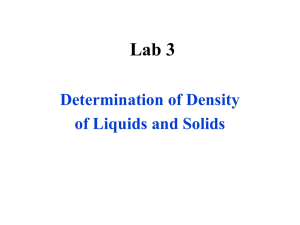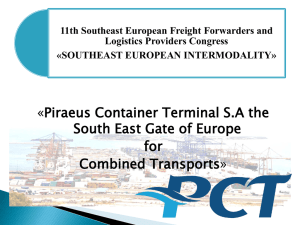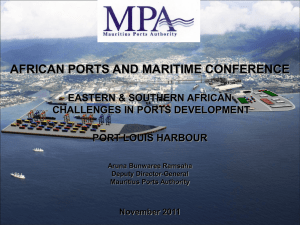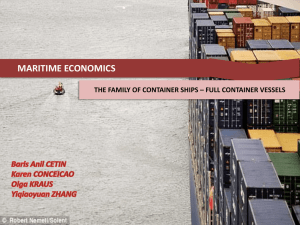4. Development of Dry Port
advertisement
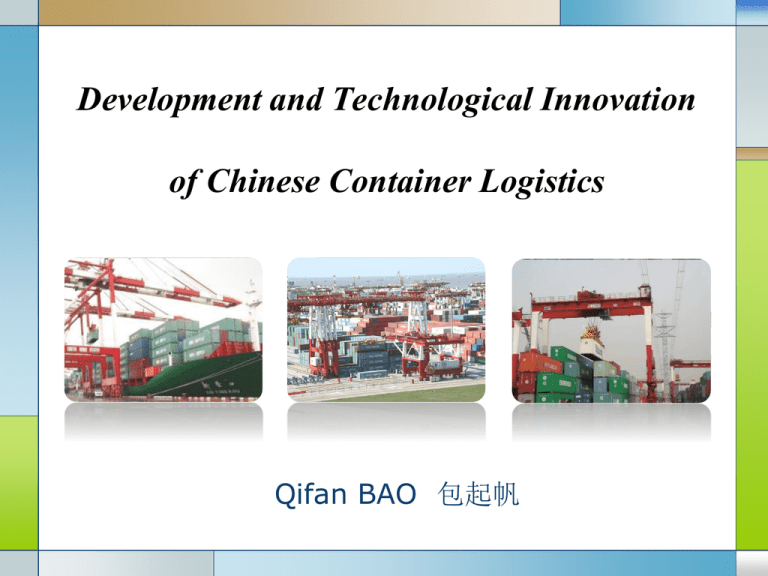
Development and Technological Innovation of Chinese Container Logistics Qifan BAO 包起帆 1. Overview of Chinese Container Transportation in 2012 Chinese main ports(capacity above 2 million TEUs) handled 176.51 million TEUs in 2012, at an growth rate of 8.1% compared with year 2011. Million TEUs Composition of Main Ports Throughput in 2012 • International Lines: Foreign trade container 105.83mTEUs were up 2.1% on the corresponding period in 2011. Growth rate slowed down 3.4% due to the unbalanced development of foreign trade. • Domestic Trade: Rapidly increased to 48.22mTEUs, up 16.5% on the corresponding period in 2011. • Domestic Trade is the key drivers of container throughput. Domestic Trade Container Transportation Booming Growth rate were above 20% every year in last 10 years. 2.Overview of Container of Shanghai Port Shanghai port, located at the intersection of the famous golden waterway Yangtze River and the coastal transport corridor, is the biggest cargos distribution center and transshipment port in China. Container port of Shanghai mainly distributed in three major Terminals: Yangshan, Waigaoqiao and Wusong, with a total 45 berths, 160 QCs, 463RTGs and 6,719,946 m2 yards. Port Coastline length (m) Berth Quay crane Yard(m2) SCT 2,281 10 20 550,932 Waigaoqiao Phase I 900 3 11 238,014 Waigaoqiao Phase II &III 1,565 5 26 750,000 Waigaoqiao Phase IV 1,250 4 16 687,000 Waigaoqiao Phase V 1,100 4 16 687,000 Waigaoqiao Phase VI 950 3 11 619,000 Yangshan Phase I 1,600 5 18 860,000 Yangshan Phase II 1,400 4 16 528,000 Yangshan Phase III 2,800 7 26 1800,000 Total 123,896 45 160 6,719,946 The World No.1 Container Throughput Container Throughputs of Shanghai Port, 1990-2012 Million TEUs 35 32.53millionTEUs 30 25 20 15 10 5 2012 2011 2010 2009 2008 2007 2006 2005 2004 2003 2002 2001 2000 1999 1998 1997 1996 1995 1994 1993 1992 1991 1990 0 3. Technical Innovation of Shanghai Port On the way to world class port, Shanghai is reinforcing its technical innovation as the core competence. Increase the Container Logistics Transparency and Security Automated Container Yard Energy-saving & Emission-reducing Reconstruction for RTGs On Shore Power Supply for Container Vessel Increase the Transparency and Security of Container Logistics To increase the transparency and security in the whole container logistics, SIPG invented the Container RFID Shipment Tag System. The system takes containers as its tracking object. Based on the Internet, it uses technologies such as RFID, wireless data communications to record the real-time security information of cargos, and construct a network covering the world of container transportation. The system allows the users learn about the right information of tagged container at any time and any places. It makes all customers’ information access initiative, compared with original passive one. E-tags had been implemented in logistics monitoring and more than ten international container lines, including China, U.S, Canada, Japan, Russia, Malaysia, etc. Particularly, Malaysia Customs has used the e-tags in all its 200 border checkpoints. Based on vast practice, ISO 18186 :2011 Freight Containers – RFID Cargo Shipment Tag System was published by ISO on 1st Dec., 2011. Research and Application on Monitoring System based on Satellite Communications Satellite Positioning Satellite Communications Information Input Ground Cellular Base Station Internet Satellite Gground Sstation+Web Server Automated Container Yard 2006 , the first automated container yard in China was completed in Waigaoqiao Phase II, Shanghai: OCR system of intelligent gateway auto-identifies the containers; Hoisting gear can identify various trucks; Central control system conducts the container truck by video and lndicator lamp; Gantry cranes finish container truck loading /unloading and stack automatically. Automated container yard trial has well performed around one million containers since March 15, 2006. Energy-saving & emission-reducing reconstruction for RTGs It is reported that ports comprise the single largest fixed source of air pollution. The power supply of RTG depends on its own diesel generator,which results in a low energy conversion efficiency and high diesel consumption, and brings huge pollution to the port city. Since 2006, Shanghai Port has begun to use electricity for RTG energy supply. Overhead electricity power sliding lines Overhead power lines are laid on the same direction of RTG on the yard. RTG works with electricity through an extra connecting device. Waigaoqiao Terminal of Shanghai Port has adopted this system for years. Every year it may save 1.25 million USD (10,902 tons of standard coal equivalent energy) and reduces 22,895 tons of CO2 emissions. There’s no more diesel engine exhaust and noise pollution. Hybrid power system for RTGs Hybrid power system for RTG is a good choice for Shanghai Yangshang Terminal because of its inconvenience of using mains electricity supply. The principle is to save the energy when crane offload container, then convert it into electricity, and being provided to RTG when it needs. The fully implement of hybrid electrical RTGs in Yangshan Terminal of Shanghai saves around 4 million USD (4,592 tons of standard coal equivalent energy), and reduces 9,645 tons of CO2 emissions every year. Super-capacitor Room On shore power supply for container vessel It is recorded that 61,873 large-scale ships berthed Shanghai Port in year 2009. Shanghai suffers 33,800 tons of harmful substances and 912,400 ton of CO2 emitted by such ships, due to vessel’s diesel generators. 2010,Shanghai started the R&D and implement of on shore power supply system. container liner berthing on Shanghai in year 2010 Movable Voltage-variable and Frequency-variable on shore power supply system 10KV/50Hz 690V/50Hz Variable Voltage 690V/60Hz Variable Frequency 440V/60Hz Variable Voltage Put out Put in Main power supply module+Cable Reels Module Successful Trial March 2010, the system successfully provided on shore power to CSCL "new Fuzhou" at the Waigaoqiao Terminal Phase II. The Waigaoqiao container terminal phase II is the first container terminal that can provide on shore power supply. Distribution boxes for vessel are equipped on berth. When the cable plug is plugged into the distribution box, electricity can be provided with the frequency-variable mode of high-voltage 10kV, 50Hz to vessels (450V/6.6kV, 60Hz). 4. Development of Dry Port A dry port ( inland port) is an inland intermodal terminal, offering services as the coastal ports, such is customs clearance, storage of goods, etc. In China, dry port has become the focus of development in recent years. Cargo Contracting Inland Port Port Service Cargo Tracking virtual dry port Coastal Port After years of development, dry port has enlarged its scale, perfected the services and formed the following three modes. For more Source of goods, coastal ports initiatively cooperate with inland cities to build dry ports: Ningbo Port set up more than ten dry ports near the city and Tianjin Port constructed 22 dry ports.; To further develop the local economy: Nanchang built the dry port to transshipment cargo to Xiamen Port, Shenzhen Port and Ningbo Port by Sea-railway transportation; According to self-development , coastal port enterprises construct dry ports: Harbin, Changchun and Shenyang have established dry ports based on Dalian Port. 5. Conclusion Outlook of Chinese Container Transportation in 2013 Steadily increasing throughput,estimated 192 million TEUs,at an 8.5% annual growth. Sustainable growth of domestic trade, at an estimated 16% annual growth. Development Trends of Ports in China Eco-friendly Specialization , intellectualization and automation of Equipment Informatization

